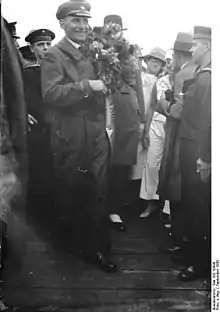Wolfgang von Gronau
Hans Wolfgang von Gronau (25 February 1893 - 17 March 1977) was a German aviation pioneer and Luftwaffe general. During World War II he was the German air attaché and the chief of the Luftwaffe liaison staff in Japan.
Wolfgang von Gronau | |
|---|---|
 Wolfgang von Gronau being welcomed back home at Templiner See after his 1930 transatlantic flight | |
| Born | 25 February 1893 Berlin, Kingdom of Prussia |
| Died | 23 October 1977 Frasdorf, West Germany |
| Buried | |
| Allegiance | |
| Service/ | |
| Years of service | 1913–1919 1936–1945 |
| Rank | |
| Awards | Harmon Trophy |

Biography
Wolfgang von Gronau was born in Berlin in a family hailing from the ancient dynasty of the House of Berg. He was the son of artillery General Hans von Gronau (1850–1940) and Luise Gerischer (1867–1926).[1]
Right before World War I he joined the Imperial German Navy where he was put in charge of a flying boat squadron. After the disbandment of the imperial military in 1919 von Gronau had reached the rank of Oberleutnant zur See, highest lieutenant grade in the German Navy.
On 18 August 1930 von Gronau flew on a transatlantic flight on a Dornier Wal —the old D-1422 flying boat that Amundsen had flown earlier. He took off from Sylt (Germany) through Faroe Islands,[2] Iceland, Greenland and Labrador, reaching New York City after covering 7,520 km (4,670 mi) in 47 flight hours.[3]
On 21 July 1932 von Gronau flew from Germany around the world on another Dornier Wal flying boat —named "Grönland Wal" (Greenland Whale)— with a crew of three people. He returned 111 days later, on 10 November, after having taken off from List auf Sylt westwards across Iceland, Greenland, Canada, the Aleutians, Alaska, the Kurils, Japan, China, the Philippines, Indonesia, Malacca, Burma, Ceylon, India, Iran, Iraq, Cyprus, Greece and Italy, landing finally in the Lake of Constance after having covered over 44,000 km (27,000 mi).[3]
In 1934 he became the president of the Aeroclub von Deutschland and in 1935 vice president of the Fédération Aéronautique Internationale. Von Gronau was posted to the German Embassy in Tokyo as air attaché shortly before the outbreak of World War II. He lived as a diplomat in Japan until the end of the war, having reached the rank of Major general when the Third Reich was disbanded.
In 1947 von Gronau moved to Upper Bavaria. He died in Frasdorf in 1977 while he was living in retirement. His remains were buried in List auf Sylt, close to the tomb of his wife.
Honours
Wolfgang von Gronau won the Harmon Trophy in 1932. In List auf Sylt stands a stone memorial to his flying boat exploits.
The Gronau Nunataks (69°27′N 30°15′W) and the Gronau Glacier (69°29′N 30°54′W) in northern King Christian IX Land, Greenland, were named after him.[4]
A street in the capital city of the Philippines, Manila was named after him, although misspelled as Von Granao.[5]
Bibliography
- M. Michiel van der Mey: Dornier Wal – „A Light coming over the Sea“.
- Wolfgang von Gronau. Pionierflüge mit dem Dornier-Wal. Luftfahrt-Verlag Walter Zuerl, Steinebach-Wörthsee
References
- Gothaisches Genealogisches Taschenbuch der Adeligen Häuser. Part B, Justus Perthes, Gotha 1941.
- Jógvan, Arge (2010). Føroya í flogsøguni : frá Charles Lindberg til Erlu Kongsdóttir. Arge, Niels Juel. Tórshavn: Tjarnardeild. ISBN 9789991883304. OCLC 846468811.
- Wolfgang von Gronau, Im Grönland-Wal. Dreimal über den Atlantik und einmal um die Welt. R. Hobbing, Berlin 1933
- "Catalogue of place names in northern East Greenland". Geological Survey of Denmark. Retrieved 18 June 2016.
- FilipiKnow. "17 Most Unusual Street Names in Manila (And Their Origins)". FilipiKnow. Retrieved 2022-04-14.
External links
 Media related to Wolfgang von Gronau at Wikimedia Commons
Media related to Wolfgang von Gronau at Wikimedia Commons- Literature by and about Wolfgang von Gronau in the German National Library catalogue
- Newspaper clippings about Wolfgang von Gronau in the 20th Century Press Archives of the ZBW